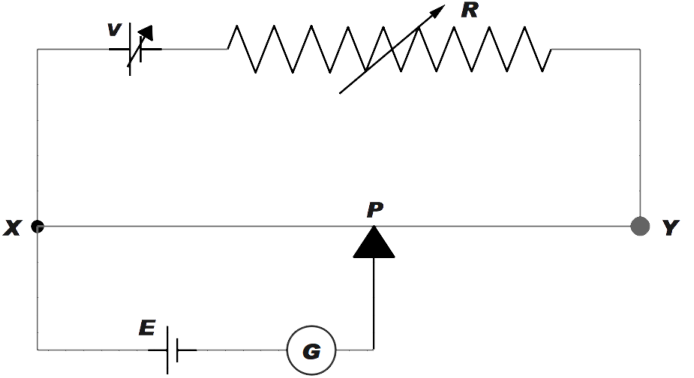
A potentiometer circuit shown in the figure is set up to measure the emf of cell E. As the point P moves from X to Y, the galvanometer G shows the deflection always in one direction, but the deflection decreases continuously until Y is reached. The balance point between X and Y may be obtained by:

A. Decreasing the resistance R and decreasing V
B. Decreasing the resistance R and increasing V
C. Increasing the resistance R and increasing V
D. Increasing the resistance R and decreasing V

Answer
494.7k+ views
Hint: In this question we have been asked to determine what conditions in the above circuit will balance the point in between X and Y. To solve this question, we will first assume zero deflection in galvanometer i.e. point P is at point Y. We will then find the total current in between point X and Y. later, in the equation obtained we will apply the conditions such that point P moves toward point X.
Complete step-by-step answer:
Now, first let us assume that point P is at point Y and there is no deflection in the galvanometer. The current flowing between point X and Y is say ‘i’.
Now, let the total resistance between these points be ‘r’.
Therefore, the current i flowing in XY will be given by
Also, as XY is parallel to emf E, the emf E will be given by
We need the point P to move towards the point X and obtain a deflection in that direction. To do so, we will have to reduce the resistance r in XY or increase the current flow in XY.
Now from (2)
We can say that to increase the emf E we will have to increase the current flowing in XY assuming r is kept constant.
Also, from (1) it is clear to us that to increase the value of i, either the value of resistance R is to be decreased or the value of is increased. So, decreasing the resistance R or increasing V we can obtain the balance point between X and Y.
So, the correct answer is “Option B”.
Note: A galvanometer is an electromechanical device that is used to detect or indicate the current flowing in a circuit. The galvanometer consists of a solenoid coil. If the current flows through this coil in an anticlockwise direction the galvanometer deflects on the right side. The galvanometer, unlike the ammeter, does not only show the magnitude of current flow but also the direction of the flow of current.
Complete step-by-step answer:
Now, first let us assume that point P is at point Y and there is no deflection in the galvanometer. The current flowing between point X and Y is say ‘i’.
Now, let the total resistance between these points be ‘r’.
Therefore, the current i flowing in XY will be given by
Also, as XY is parallel to emf E, the emf E will be given by
We need the point P to move towards the point X and obtain a deflection in that direction. To do so, we will have to reduce the resistance r in XY or increase the current flow in XY.
Now from (2)
We can say that to increase the emf E we will have to increase the current flowing in XY assuming r is kept constant.
Also, from (1) it is clear to us that to increase the value of i, either the value of resistance R is to be decreased or the value of is increased. So, decreasing the resistance R or increasing V we can obtain the balance point between X and Y.
So, the correct answer is “Option B”.
Note: A galvanometer is an electromechanical device that is used to detect or indicate the current flowing in a circuit. The galvanometer consists of a solenoid coil. If the current flows through this coil in an anticlockwise direction the galvanometer deflects on the right side. The galvanometer, unlike the ammeter, does not only show the magnitude of current flow but also the direction of the flow of current.
Recently Updated Pages
Master Class 12 Business Studies: Engaging Questions & Answers for Success

Master Class 12 English: Engaging Questions & Answers for Success

Master Class 12 Social Science: Engaging Questions & Answers for Success

Master Class 12 Chemistry: Engaging Questions & Answers for Success

Class 12 Question and Answer - Your Ultimate Solutions Guide

Master Class 11 Economics: Engaging Questions & Answers for Success

Trending doubts
Draw a labelled sketch of the human eye class 12 physics CBSE

a Tabulate the differences in the characteristics of class 12 chemistry CBSE

Which one of the following is a true fish A Jellyfish class 12 biology CBSE

Why is the cell called the structural and functional class 12 biology CBSE

Differentiate between homogeneous and heterogeneous class 12 chemistry CBSE

Write the difference between solid liquid and gas class 12 chemistry CBSE




